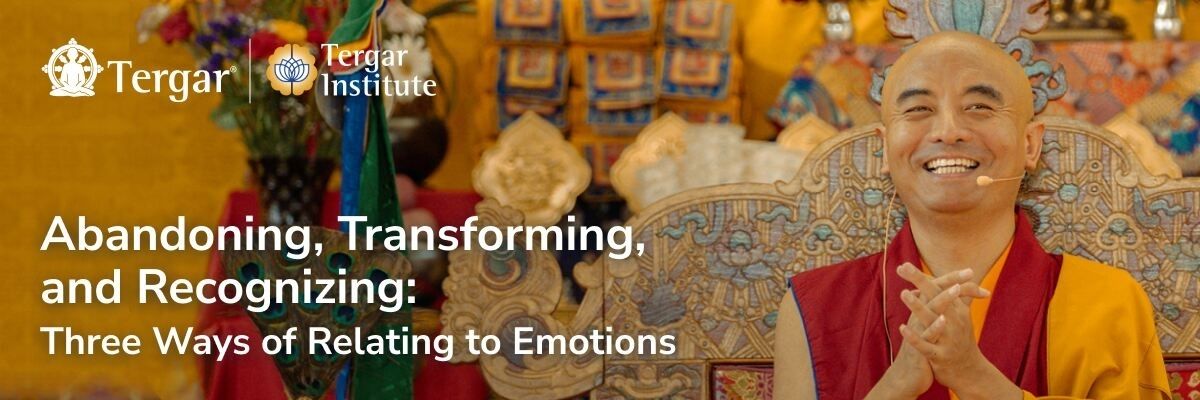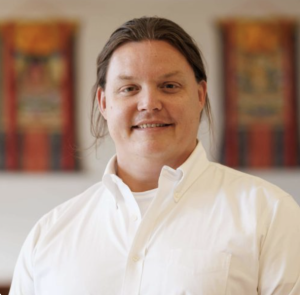Abandoning, Transforming, Recognizing Retreat Encompasses Totality of Practice
By Justin Kelley • 3 min read
By Justin Kelley • 3 min read

This November, Mingyur Rinpoche will offer a special three-day retreat at Tergar Osel Ling Monastery in Kathmandu, Nepal, titled Abandoning, Transforming, Recognizing: Three Ways of Relating to Emotions. Justin Kelley, co-executive director of Tergar Institute, shared his thoughts about what makes this program unique and why it holds special meaning for practitioners around the world.
WHETHER MINGYUR RINPOCHE is teaching Joy of Living or the most senior levels of the Path of Liberation, everything can be understood through these three aspects. Likewise, abandoning, transforming, and recognizing — or this tripartite framework, as we might call it — encompasses the totality of practice.
What’s beautiful is that, in this three-day retreat, Abandoning, Transforming, Recognizing: Three Ways of Relating to Emotions, Mingyur Rinpoche is going to systematize these approaches in a way that allows us to understand not only how they function individually but also how they function in collaboration with each other. As Rinpoche likes to say, they provide us with a “more nuanced toolbox of approaches” that we can utilize when faced with difficult emotions and challenging situations — incredibly valuable for practitioners of all levels.
We can sit at home and listen to Rinpoche’s teachings, but to come to a place like Tergar Osel Ling Monastery, where people have been practicing for so many years and where the monastic community is so welcoming and supportive for practitioners — these things, coupled with the fact that you can see Rinpoche in person, make the transmission that much more potent.
It’s always profound to hear Rinpoche, but sitting in this particular meditation hall, in this particular location, above the sacred site of the Swayambhunath Stupa, where practitioners are said to have engaged in practice for millennia, just takes the experience to another level, and I think allows people to really hear what Rinpoche is transmitting in a way that is not possible from a distance. So the location of hearing the teachings is tremendously profound.
The city of Kathmandu itself is busy, even hectic, but as you head up to Osel Ling, perched on a hill overlooking the Kathmandu Valley, you find that peace that the Himalayan people have so long embodied — and still do — and we can get a taste of that.
There’s also a diversity of practitioners that come together at Tergar Osel Ling that is very supportive. If we understand the practice, it is really a reimagining of ourselves and, at times, deconstructing ourselves or re-understanding ourselves. The diversity that comes together at programs like this helps to facilitate this process, because people come with such a diverse array of practices, cultural backgrounds, and ways of being that might help us decentralize our own particular way and open our minds to different possibilities. So it’s almost as if the teachings are acting on so many levels, and then the community itself can impact us and help facilitate this journey that Rinpoche is taking us on.
This retreat is the first of its kind in that it’s a collaboration between Tergar International and the Tergar Institute — really, the best of both worlds. Tergar International has set forth a wonderful precedent in programming and facilitating Rinpoche’s profound teachings. The collaborative piece comes in through the pedagogical approach that we’re employing for this retreat. We’re taking the Tergar Institute’s “cycle of learning” process, which sequences the teachings in a way that provides a broader range of inputs and a broader range of engagement with the teachings. Mingyur Rinpoche will provide the pith instructions, and the lamas and khenpos will give commentary on these topics. The international faculty from Tergar Institute will provide seminary-style instruction.
Lastly, there will be a Compassion in Action session where we’ll explore how these teachings can directly impact our personal and professional lives. Of course, all these components are present throughout Mingyur Rinpoche’s teachings when he teaches the “view, meditation, conduct,” but we’re parsing them with a little more detail and embracing the way that Tergar Institute has structured programming.
We look forward to seeing you in Kathmandu! And if the journey is not possible, then online!
October 2025

Justin Kelley’s journey began on a farm in rural Massachusetts before spending a decade immersed in Tibetan refugee communities in India and Nepal. He studied Tibetan language, Buddhist philosophy, and meditation, culminating in a PhD in Religious Studies from Rice University under Dr. Anne C. Klein. A passionate educator, Justin emphasizes inclusivity and empathy, creating transformative learning experiences both in-person and online.
Learn meditation under the skillful guidance of world-renowned teacher Yongey Mingyur Rinpoche at your own pace.


“The practice of meditation allows us to relax this misguided search for happiness in the objects of experience. It allows us to settle and connect with the unchanging peace, the natural wellbeing that is the very nature of mind itself.” – Tim Olmsted

If we’re coping with a heavy, complicated problem, we’re often too busy to feel lonely. But sometimes, loneliness itself becomes our major problem. What’s happening is that our monkey mind is zooming in on the feeling, exaggerating it. Sometimes we think, “I don’t really have any good friends,” when what we really mean is we…

He appreciated Rinpoche’s emphasis on applying the teachings anywhere and anytime. “I wanted a spiritual path that would infuse the entirety of my life,” Kell recalled.
If you enjoyed reading our articles, please join our mailing list and we’ll send you our news and latest pieces.